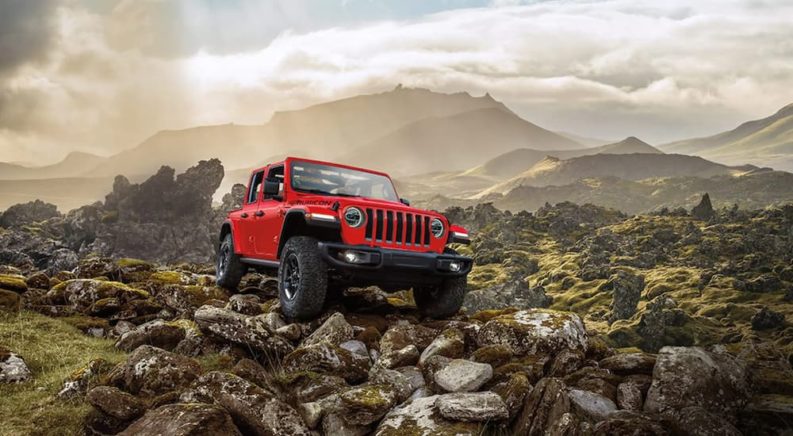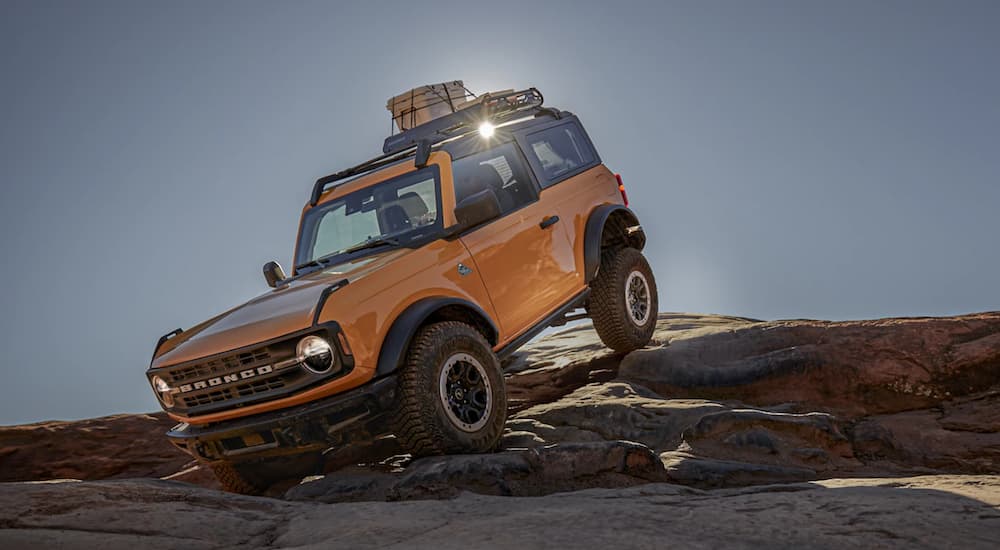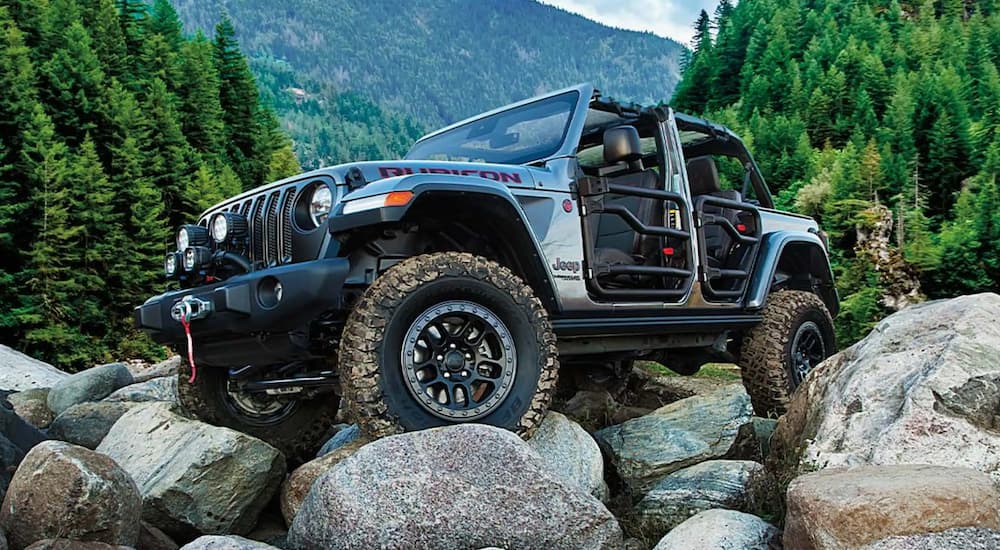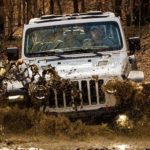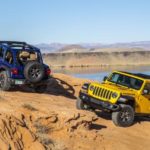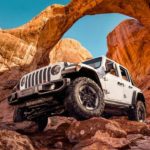It’s a tale as old as time and a song as old as rhyme – but there ain’t no beauty in the game when looking at the 2021 Jeep Wrangler vs 2021 Ford Bronco. This one is strictly Beast vs Beast, thank you very much, and it always has been since the Bronco’s introduction back in 1966. It’s been more than twenty years since a comparison of the two models has been relevant, but Bronco’s revival as a genuinely competent off-roader and Jeep’s development of the Wrangler Rubicon 392 makes it a hot topic once again.
So which one’s better? Well, it depends on what you want and what you need. When loaded up, high trim Broncos seem to have the edge in nearly every department. Competitive specs and excellent driver-assist technologies make it a little more accessible to novice off-roaders. However, don’t discount the Rubicon 392’s V8 power or the 80+ years of continuous refinement that the Wrangler benefits from. At the other end of the spectrum, if you’re looking to get a cheap off-roader, the better pick depends on what you need. The Bronco Base is more spacious, more powerful, and more capable with 3,500 lbs towing for camping adventures, while the Wrangler Sport is more nimble with better off-roading geometry, making it a better trail runner.
Alright, glad we got that out of the way, right? But you’re here, so you probably have a deeper appreciation for a vehicle’s character than the specs can tell. The Wrangler and Bronco are nothing if not enthusiast’s vehicles, so there’s a lot more than raw performance that matters to their customers. A lot of that je ne sais quoi can come from a vehicle’s exclusivity (“They only made 17 ½ of these bad boys; I’ve got the ½!”) or customizability (“I selected the bike rack and the kayak rack, with an overhead tent platform and zebra stripe decals – it doesn’t fit in my garage, but it does fit my style!”). But a lot comes from a car’s heritage too, and with stories that go back more than 80 years, the Wrangler and Bronco each have a ton of history behind them.
We All Have Something in Common
The Wrangler name was first used in 1987; Bronco in 1966. But to see where these vehicles came from, we have to look all the way back to the early 1940s, when a contract was awarded to Willys, Ford, and American Bantam to produce a general-purpose vehicle for military use. Over 650,000 of these vehicles were built – 250,000 by Ford – by the end of World War II, earning it legendary status as a key instrument in the defeat of Nazi Germany. Confident under duress while going over any terrain, it “Jeep” a household name and was the inspiration for generations of super-capable off-roaders.
The Willys MB was transformed after the war into an all-new kind of civilian-friendly utility vehicle. The original Willys CJ (“Civilian Jeep”) was marketed as a tractor alternative for farmers and sparked a 40-year run that saw five major variants enter production. With a reputation for reliability and mechanics that were easy to fix and near impossible to break, there was nothing on the market that more strongly embodied the American ideals of independence, self-reliance, and self-determination. The Jeep name became official shortly after the sale of Willys to Kaiser Motors in 1953, and it was the CJ-5 produced under their management that Ford would go up against ten years later with the original Bronco.
In 1963 a memo went out at Ford with the subject line “1966 G.O.A.T.”, referring to the “Goes Over Any Terrain” attitude they wanted from the sport utility vehicle that was developing alongside the nascent Mustang. With feedback in hand from CJ-5 and Harvester Scout owners to inform their design, Ford came up with a unique platform for the 1966 Bronco. As such, they kept it simple for low costs, but with coil spring suspension, the handling was ahead of its time, boasting better on-road manners and off-road articulation than leaf-sprung counterparts. The world’s first self-identified SUV was an immediate success in the off-road racing world. A stock model won the 1969 Baja 1000 in record time, and the legendary Big Oly truck, a modified Bronco built by Parnelli Jones and Bill Stroppe, won again in 1971 and 1972.
Not Just a Utility Vehicle Anymore
While the Bronco disappeared over a dusty horizon, Jeep changed hands again, this time being picked up by AMC in 1970. The CJ-5 carried on thanks to increasing popularity, and a larger CJ-7 arrived in 1976 at the end of the oil crisis. That release corresponded to the second-gen Bronco, built on the F-100 platform with significantly larger dimensions and more truck-like handling than its predecessor. Bronco’s signature roll-down tailgate window was introduced at this time; the removable fiberglass hardtop over the rear cabin area was a nod to the roadster style that Ford had discontinued but which remained popular with Jeep customers.
Bronco would get a full third generation to continue refining itself, introducing new features like the Twin-Traction Beam swing axle that was halfway between solid axle and control arm technology, before AMC released the first Jeep Wrangler in 1987. Built on an all-new platform, the YJ Wrangler was designed with on-road handling in mind for wider appeal. AMC would no longer be around to see the end of that episode, however, as they were bought by Chrysler that same year and Jeep changed hands one more time.
However, the Wrangler continued to be less luxury-focused than the Bronco. The fourth-gen Bronco had standard ABS in 1987; the Wrangler acquired this feature in 1993. Ford was also the first (of any maker on any model) to integrate turn signals into the side mirrors when they added this feature to the Bronco in 1996! Despite this legacy of innovation in the SUV field, however, the increasing popularity of small 4-door SUVs spelled the Bronco’s doom, and after 1996 – 30 years and 1.15 million units after the initial release – the Ford Bronco would be found exclusively on used car sales lots.
A Class of Its Own
While the full-size Bronco and midsize Wrangler weren’t direct competitors in the ’80s and ’90s, is there any doubt where would-be Bronco owners turned to in its absence? Bronco’s demise coincided with the release of the excellent 1997 TJ Wrangler, a second-generation overhaul that reinvented “the Ultimate Escape Machine.” A quadra-coil suspension improved every suspension-related aspect of the vehicle’s performance, and the ’97 model became the 5th Jeep to win “4×4 of the Year”. For years, Wrangler sold in the hundreds of thousands with hardly any updates, until 2003 when it gained a 4-speed automatic transmission, a Chrysler engine (16 years after the sale of AMC), and the class-topping Rubicon trim package with its Dana 44 solid rear axle and Tru-Lok front and rear lockers.
Ford merely teased the market with a wicked retro-futuristic Bronco concept in 2004, while Jeep continued to refine the Wrangler. The Wrangler Unlimited, with a longer wheelbase and more cargo room, exhibited greater on-road comfort and towing capabilities, becoming the first Wrangler 4-door in 2007 with the 3rd gen JK Wrangler release. Still sporting an ancient engine (a 1991 Chrysler model), it wasn’t until 2012 that the Wrangler got a Pentastar V6 that could actually be considered modern at the time of the change.
It seems funny that for so long, the Wrangler sported outdated engines. However, Jeep’s emphasis was on continuing to improve the on-road character and off-road capability of the Wrangler; presumably, an old but reliable engine was preferable to a less-tested modern design. Using other tactics to improve the Wrangler’s safety, efficiency, technology, and performance took precedent. Of course, that only lasted while they had time in the market to themselves – and in 2018, time started running out.
Modern Titans
The 2018 announcement of a new line of Ford Broncos, 22 years after the last one had rolled off the line, essentially put Jeep on notice. The 2019 JL Wrangler was another huge advancement in styling and performance, with three different 4×4 systems to choose from depending on how you wanted to use your Wrangler. Plus, with the 4xe plug-in hybrid on the way, Jeep has a jump start on a new frontier in off-road vehicle design with 375 hp and 470 lb-ft from a 49 MPGe off-roader.
But there’s no way that’s going to be enough. That’s because the new Bronco is poised to introduce more new technology, continuing Ford’s tradition of being the first to bring novel ideas to segment, and it already outperforms the Wrangler in almost every way, from towing to torque to maneuverability. It isn’t a surprise that the announcement of the 2021 Bronco’s release was followed shortly by Jeep announcing the Rubicon 392, the first Wrangler to ever house a V8 engine. With 470 hp and 470 lb-ft, this beast will be 4.5 seconds-to-60 quick and is sure to be the most capable Wrangler ever sold; first impressions are that they’ll need it to be.
Paths Intertwined, but Never Together
Who got the 20-year head start on whom? For 21 years, Willys was making Jeeps while Ford let the segment lie. But then Ford’s Bronco celebrated its 20th anniversary the same year that Wrangler first came to market. Now it’s once again been Wrangler who had 22 years to refine its craft while the Bronco name slept. However, one can’t discount Ford’s role in the conception of the original Willys MB, nor the off-roading prowess that was developed through models like the Ford F-150 Raptor while the Bronco name was not in use. Despite the relatively brief window during which new Wranglers and Broncos graced the trails, both models trace a direct lineage through 80 years of development.
Now the stage is set for the Bronco and the Wrangler to truly go head-to-head in the segment for the very first time. With its military roots and Trail Rated status, the Wrangler is always a good bet, especially with the new Rubicon 392 and Wrangler 4xe versions coming out. But the Bronco is ready for hauling even in its stock trim, with highly competitive and novice-friendly off-roading capabilities, especially at higher trims. One thing’s for sure – when these two go head to head, no place is off-limits.

